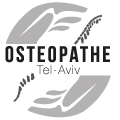Osteopathy: how does it work?
Osteopathy is based on an ascertainment: Different parts of the body (joints, muscles, ligaments, organs) are interdependent. Therefore, a malfunction leads to an imbalance within other structures remotely located. The osteopath has a comprehensive approach:
He does not just act upon the symptom, but looks for the root cause of the problem. In order to relieve back pain for instance, it may well be required to treat a foot or stomach.
A second fundamental basic: In order to function properly, each part of the body must be free of organic lesions, but also be properly vascularized, nourished and cleansed of toxicity by the blood and lymph. If some disorders prevent liquids to flow freely, pain will appear. The osteopath will therefore examine mobility loss of tissue and signs of blockages that will arise.
Who turns to Osteopathy?
Toddlers, children, pregnant women, adults or seniors: everyone can benefit from Osteopathy to relieve many troubles. It acts on the musculoskeletal system (tendonitis, joint pain, tailbone …) and nervous system (cervical-brachial neuralgia, sciatica, insomnia, hyperventilation …). It can be beneficial in treatment of circulatory disorders (hemorrhoids, venous congestion …) and digestive disorders (hiatal hernia, colitis, constipation …). Finally, it can treat ENT and respiratory problems (sinusitis, tinnitus, asthma, some migraines) or even genitourinary (gynecological pain, cystitis, enuresis …).
But it knows its limits. Osteopathy will never be enough to cure cancer, fracture, cystic fibrosis and multiple sclerosis; although it can still intervene to complement conventional medicine in order to help heal the body and also support other treatments.
What is Osteopathy?
Osteopaths treat the body as a whole no matter the subject of consultation. Pain is only an effect to a source that must be found and treated. For example, your back pain might come from an ankle problem. One of the roles of your osteopath is to discover the origins of pain (mobility dysfunctions) and treat it by means of an effective treatment for the long run through the stimulation of the self-healing capacities of the body.
The various techniques used (structural, visceral, cranial and facial) are always done in a gentle manner and painless for the patient.
Osteopathy is also an act of prevention of future functional disorders in the human body.
Why consult an osteopath?
The disorders treated by osteopathy are many, it treats:
Joint pain and muscle pain:
• LBP: lumbago, sciatica …
• Back pain, neck pain: torticollis, whiplash …
• Sprains: ankles, knees, wrists …
• Tendonitis, tennis elbow, pubalgies …
• Scoliosis
The nervous and vascular system:
• Migraines
• Sleep disorders, state of anxiety, stress
• Neuralgia: cruralgia, sciatica
The digestive system and visceral:
• Digestive disorders: constipation, diarrhea, bloating, GERD …
• Urinary genital disorders: painful menstruation, pregnancy care, pain during
intercourse …
• ENT disorders: chronic sinusitis, asthma, chronic bronchitis, chronic rhinitis …
Post-trauma effects:
• Road accident
• Fall on the skull, tailbone …
• Post surgery pain
• Sprains and fractures
Your osteopath adapts itself for each patient because each one is unique.
Your osteopath also comes to your home or your workplace, if needed.
Osteopathy, for whom is it?
One may benefit from osteopathy for a lifetime, from infant to senior. Depending on age, morphology and life of the patient, the osteopath adapts and uses its skills to treat toddlers, children, pregnant women, adults and the elderly as well as professional and
amateur athletes.


